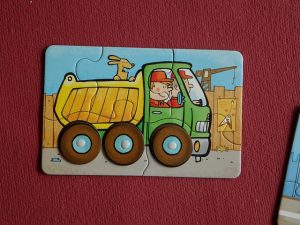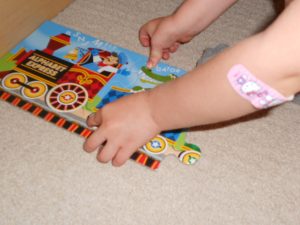Sometimes we forget there are other ways to play with cars, trucks, trains, and boats than tracks and roads. How about some transportation puzzle play?

No matter what the form of transportation or the material of the puzzle–wood, foam, or cardboard, play with puzzles pieces together lots of fun and learning. These points below are only part of the activity happening in the brain and body:
- problem-solving: Finding where each piece fits is a mini problem. What strategies does your child use to come up with a solution?
- noticing details: Kids learn to look at the color, size and shape of pieces.
- spatial skills: As little hands match the pieces to the spaces, brains are learning to do the same thing. (Some adult brains can tell if a sofa fits in a space just by looking but some have to move it.) The ability of children to manipulate shape and space mentally is an important predictor of later skill in this area and playing with puzzles can help build this.
- memory: Children will do a puzzle over and over and stretch their memories remembering which pieces fit where, what the finished picture looks like, and more.
- muscle development. The small muscles in the hand and arm are developing and need lots of experiences making small movements.
- hand-eye coordination: Getting fingers and hands to coordinate with brain instructions can be tricky.
- attention and concentration: A puzzle is very patient and will still be there as children get distracted but at the same time, eyes and hands remind kids to return to the puzzle.
- satisfaction and confidence: Kids feel pleased when they finish a puzzle and this boosts confidence in their abilities.

Puzzles, like everything else, seem to be getting more expensive, but you might find some at garage sales or toy lending libraries. They are a toy kids can play with over and over, going from needing some help to being able to do them by themselves. Any transportation puzzle play in your child’s day?
